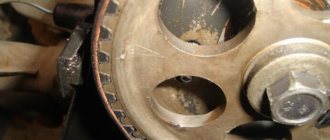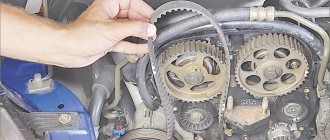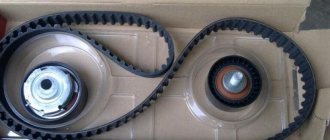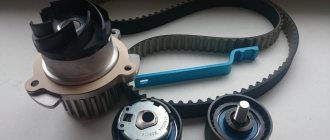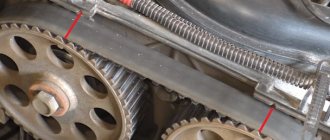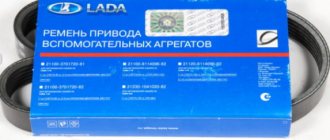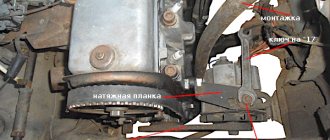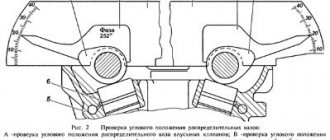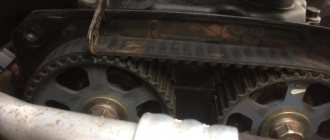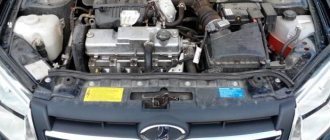Unlike a timing chain drive, in cars with a belt drive, it is the timing belt that is quite the weak point. If a break occurs, the engine will not only stop working, but may also require serious repairs. The reason is that on many engines the valves bend when the timing belt breaks, with all the ensuing consequences.
To avoid problems, the condition of the belt and rollers must be monitored, and the timing belt must be changed strictly according to the regulations. It is important to set the timing belt correctly. Next, we will look at how to change the VAZ 2109 timing belt, as well as what timing marks on the 2109 timing belt you need to pay attention to when replacing it in order to install the belt correctly.
How to set the VAZ 2109 timing belt correctly?
To work, you will need keys 17 and 19, a flashlight and a flat-head screwdriver. Remove the old belt and roller completely (just be careful not to lose the washers placed under and on it). Install a new tension roller VAZ 2109, and then begin adjustment.
Using a wrench, turn the camshaft pulley until the mark on it aligns with the bar attached to the engine block. After this, try not to touch the camshaft so as not to knock it down (although this is quite difficult to do, but if desired, everything is possible).
1. Place a mark on the camshaft:
2. Checking the alignment of the marks on the crankshaft pulley
3. Check the marks on the flywheel for more accurate installation
Place a bolt on the crankshaft so that you can align the pulley to the marks. Rotate the crankshaft until the mark on the pulley is clearly vertical - this is the very first guideline. Afterwards, to ensure correctness, remove the rubber plug in the clutch housing.
A viewing window will open, through which you can see the flywheel. So, the latter should have a mark - a line that, under normal settings, coincides with the slot on the bar attached to the engine block. This is your second reference point, which directly speaks to the accuracy of the setting. Now all that remains is to put the belt on the crankshaft pulley first, then the camshaft.
To adjust the belt tension, you need to install a special key in the timing belt roller of the VAZ 2109 (if you don’t have one, you can adjust the tension using a screwdriver and a pair of screws or nails). Normal tension is when in the longest section you can turn it a maximum of 90 degrees. Yes, it should turn, but it should turn.
If you can’t turn it at all, then the tension is excessive and needs to be loosened. This is why the VAZ 2109 tension roller exists. Loosen the nut and perform the procedure again. After this, use a wrench to turn the crankshaft several turns and double-check that all marks match. If everything is fine, assemble the unit and start the engine.
Instructions for replacing the belt on a car with an injection engine
The injector was installed on only one type of “nine” engine - with a cylinder displacement of 1.5 liters. The use of a fuel injection system did not cause any adjustments to the camshaft drive pattern. The procedure for replacing the timing belt on a VAZ 2109 with an injection engine is practically no different from the list of work on a carburetor car.
The difference is the removal of the old belt, which will require:
- Remove the crankshaft position sensor located next to the pulley from the engine. To dismantle, you need to unfasten the wiring plug and then unscrew the sensor mounting bolt. After this, the sensor is removed from the guide hole.
- To loosen the tension of the auxiliary drive belt, you need to unscrew the M13 nut installed on the generator.
The intricacies of replacing the timing belt on an injection machine are shown in the video from the Alex ZW channel.
There are also several differences when reassembling:
- The crankshaft pulley needs to be installed accordingly. To do this, you need to set the top dead center in the first cylinder - according to the mark on the flywheel and on the crankcase. In this case, the mark of the camshaft gear will coincide with the notch on the plate. The installed pulley should be located opposite the sensor with the beginning of the 20th tooth, counted from the two missing ones.
- The gap between the sensor and the pulley should be 0.4-1.0 mm.
- After completing the assembly, start and check the operation of the engine.
Check points on the pulley
Checking the timing belt tension
With the correct belt tension, the long leg should rotate 90º using the thumb and index finger. The test should not require much physical effort to complete. When retightening, additional loads occur on the bearings of the pump and tension roller, which damage them. Excessive tension is also harmful to the belt itself, which can break while the engine is running.
Preload check location
Step-by-step replacement instructions
The VAZ 2109 car is designed in such a way that if repair work is necessary, it can be carried out by the car owner himself. The process of changing the tensioner roller is quite simple, and it will take no more than 1.5 hours.
Step-by-step instructions for carrying out technical work on the timing system:
hidden spring roller
roller with external spring design
If after the work carried out, the car owner has no complaints about the operation of the engine, then the process of replacing the timing rollers in the engine is over.
Malfunctions after replacing timing rollers
In most cases, after replacing the timing belt tensioners, the car owner does not encounter any problems. However, as practice has shown, malfunctions can manifest themselves after some time.
Malfunctions and solutions:
Fault 1: The battery does not charge well; after several hours of inactivity, the car does not start. Voltage drops are also observed in the on-board electrical network.
Solution: Most likely, when installing the timing belt, the driver incorrectly adjusted the position of the shaft gears in relation to the generator gear. As a result, malfunctions in the on-board network began to appear. They arise due to the asynchronous operation of the gears described above. To eliminate this problem, you just need to debug the position of the shaft gears and the generator. After additional configuration, the problem goes away.
Malfunction 2: After replacing the rollers, the timing belt cracked or even broke.
Solution: In most cases, this problem occurs when a modified timing panel panel is installed. Such breakdowns occur due to the fact that the position of the rollers was not calibrated, as a result of which the belt was overtightened. To eliminate this problem, remove one of the rollers, then put on the belt. After this, install the removed roller back on the panel. Then adjust its position. The adjustment itself must be carried out using a special wrench, which must be used to tighten additional screws on the tensioner. When adjusting the position of the roller, you should also rotate the belt to ensure that there is no excessive pressure on it.
If any other problems occur in the engine after replacing the rollers, a simple solution would be:
Despite everything, I would like to emphasize that the VAZ 2109 car, although it is the brainchild of the domestic automobile industry, can serve its owner for many years with proper care.
Replacing the timing belt VAZ 2109 1.5 liter 8 valves with photos and videos
Old VAZ 2109 with a 1.5 8 valve engine, timing belt replacement. In general, it could be a VAZ 2114 or 2110, there is no difference in operation, the eight-valve engine is the same everywhere. Together with the belt, we will change the pump, the tension roller and two pulleys, the camshaft and the crankshaft. If the timing belt breaks, the valves on this engine do not bend, but it is better not to let it get to that point. Changing the pump and roller is a prerequisite so that after a thousand kilometers you don’t have to disassemble everything again. But it’s up to you to decide for the pulley, the price is 150 rubles per pair. There were cars where a slightly bent pulley caused the belt to slip and gradually wear out, reducing its service life. On this car the belt was worn down in half.
We recommend that you periodically check the condition of the belt to avoid annoying consequences and not have to look for someone to take it to a repair shop. Replace every 40,000 kilometers.
And here is the patient himself.
To replace it, we need a key for the tension roller, the price is half a hundred rubles. You can buy it at any auto store. As well as a set of keys and sockets and two hours of free time.
Begin
Everything we need.
We unscrew the three ten bolts securing the protective timing cover and remove it.
Next, loosen the nut thirteen that secure the generator and unscrew the tension bolt ten.
We take the generator to the engine and remove the belt.
Remove the engine protection and drain the antifreeze. We set the camshaft mark by turning the crankshaft clockwise. The ebb on the pulley should be opposite the bend of the protective cover fastening.
Unscrew the crankshaft pulley mounting bolt. We put the assistant in the cabin and force him to engage fifth gear and press the brake. And at this time we easily and naturally unscrew the bolt using a 19 meter head and a pipe of one and a half meters. It must be screwed properly, and some craftsmen lubricate it with sealant and then wait for kind words addressed to them.
On the left side we see the crankshaft position sensor. We will need it to subsequently check the correct installation of the timing belt. We remove the crankshaft pulley and see that the marks match.
Unscrew the nut on the tension roller 17 and remove it along with the belt. Then unscrew the camshaft pulley bolt and remove the last one. Be careful not to lose the key. We unscrew everything that secures the protective metal shield, namely one ten-point nut and a bolt securing the cover, three bolts securing the pump.
Remove the protective cover and pump. Antifreeze remaining in the block may leak out if you have not drained it. Carefully, it's sweet.
We clean all the parts from oil and belt residues, as well as the pump seat from the old gasket and sealant.
Lubricate the gasket of the new pump with sealant and put it in place. We install the metal protection and tighten all the bolts and nuts securing it. We tighten the pump bolts evenly in a circle, then check whether the pump is spinning. Recently a client brought in an original pump, which turned out to have slightly larger petals and after installation it began to bite. I had to modify it with a grinder and take measurements several times. These are the spare parts we have.
We check if the key is lost on the camshaft and install the pulley. We tighten its bolt to seventeen.
Now comes the fun part - installing a new belt.
We check that all marks match. We first place the belt on the crankshaft and pump. Then we tighten the right descending branch of the belt and put it on the camshaft pulley and tension roller. We check all the marks again and tighten the belt with a roller. The tension is considered sufficient if, with the force of two fingers, you can twist the longest branch of the belt by a maximum of 90 degrees. It’s easier to take the right branch of the belt with two fingers and twist it, if more than 90 is not very bad, but less is very bad. An overtightened belt will wear out quickly and will also reduce the life of the pump.
We place the bottom protective plastic cover. And on the crankshaft pulley we mark the twentieth tooth after skipping two teeth. We count counterclockwise.
This mark corresponds to the top dead center of the first cylinder. We put the pulley in place and the mark should be against the crankshaft position sensor. More precisely, against the small iron core of the sensor. Sometimes it gets into the gap between the teeth, this is considered acceptable. We tighten the pulley in the same way as we unscrewed it, with the help of a partner.
We turn the crankshaft two turns and check the marks; this is where our mark on the pulley comes in handy.
If everything is in trouble, we collect everything that we took apart. As they say in smart books, install the parts in the reverse order of removal. Don't forget to add antifreeze.
We start the car, accept congratulations from family and friends and head off to adventure.
EXECUTION ORDER
Using a 10mm wrench, unscrew the bolts of the front timing cover:
Step-by-step instructions for tensioning and replacing the timing belt on a VAZ 2109, 2108, 21099 with your own hands using a minimal set of tools. To get to the timing belt, you need to remove the protective cover. To do this, use a 10mm wrench to unscrew the two bolts on the side.
and one in the center
Removing the timing cover
To replace the belt, turn the crankshaft counterclockwise so that the mark on the camshaft pulley moves down from the rear cover antenna by two teeth.
Remove the generator drive belt, the right wheel and the right mudguard of the engine compartment. Using a 19mm socket, turn the crankshaft clockwise using the pulley bolt.
until the mark on the camshaft sprocket aligns with the mounting lug on the rear timing cover.
After removing the rubber plug at the top of the clutch housing,
make sure that the mark on the flywheel is located opposite the slot in the clutch housing cover (the coolant supply hose to the radiator has been removed for clarity).
This is how the mark should be located on the engine flywheel (with the gearbox and cylinder head removed).
We fix the crankshaft from turning by inserting a screwdriver through the hole in the clutch housing between the flywheel teeth. Unscrew the bolt securing the generator drive pulley. Remove the generator drive pulley.
Using a 17mm wrench, loosen the nut securing the tension roller.
We turn the tension roller to a position in which the belt will be loosened as much as possible and remove the timing belt.
When replacing the tension roller, unscrew the nut securing it and remove the roller from the stud.
A spacer washer is installed under the roller.
Install the timing belt in reverse order. We put the belt on the crankshaft pulley. Then we put the rear branch on the coolant pump pulley and place it behind the tension roller. We put the belt on the camshaft pulley.
By inserting a screwdriver between two screws or rods with a diameter of 4 mm installed in the hole of the tension roller, turn the roller counterclockwise, tensioning the belt. Tighten the tension roller mounting nut.
We screw the bolt securing the generator drive pulley into place and using the 19-inch head, turn the crankshaft two turns clockwise by the bolt.
We check the alignment marks of the crankshaft and camshaft.
With the generator drive pulley removed, it is convenient to control the position of the crankshaft by aligning the marks on the crankshaft timing pulley and the oil pump cover. If the marks do not match, repeat the operation to install the belt.
Timing belt for VAZ 2109 engine
Previously, the gear device was quite rare and caused some mistrust among car enthusiasts. In modern cars, such a drive is no longer uncommon. And there are a number of objective reasons for this:
- toothed belt drive is less noisy;
- simplicity of design and light weight;
- service costs less.
But, as it turned out, the belt has many disadvantages. Firstly, it is fragile (it often breaks). Secondly, with prolonged use, sagging is observed, associated with squealing. Thirdly, if you tighten the belt, its teeth will “stick together” over time, which will lead to the need for replacement and unstable operation of the power unit.
Purpose of the timing belt
The timing belt is made of rubber and has teeth with serrations on the inside. Its main task is to ensure synchronous rotation of the crankshaft and camshaft drives. Thanks to the belt, a lower camshaft speed is achieved: it is two times lower than the crankshaft speed. Unfortunately, the part does not last as long as the chain, and wears out before 60 thousand kilometers. It is recommended to replace the belt, even if there is visually no visible damage or signs of wear.
https://youtube.com/watch?v=aIOMGBmM3SM
A broken belt completely disables the engine, making it impossible to move the car. On 8-valve engines with a volume of 1.5 liters (the injector and carburetor have the same systems), a broken belt does not lead to the valves being deformed; in common parlance, the valves are bent on the valve cover.
There may be several reasons why the drive breaks.
- Natural wear of the belt or manufacturing defects (poor quality material).
- The ingress of oil and dirt, as a result, peeling of the rubber and breakage.
- The coolant pump is jammed and antifreeze is leaking.
- Tensioner pulley problem.
- Seized camshaft or crankshaft.
In order to avoid the financial costs of eliminating problems when the timing belt breaks, it is necessary, if possible, to monitor the operation of the timing belt:
- do not neglect the established regulations and promptly change consumables (belt, roller, pump, etc.);
- listen to the sound of the engine and if suspicious noises occur, immediately look for the cause;
- Check the belt tension regularly and tighten if necessary;
- monitor the warning lights on the dashboard (the oil pressure warning light indicates a malfunction);
- Avoid oil leaks; if there are any, look for the cause of the leak.
However, monitoring the condition of the belt and other drive elements is problematic due to the protective casing. To solve this problem, it is recommended to make a small inspection slot in the casing cover.
This way you can monitor the condition of the belt. And if there are cracks, scuffs and other damage, replace the drive in a timely manner, without waiting for it to break at the most inopportune moment.
How to tension the timing belt correctly
The optimal tension of the timing belt is very easy to check. Using a little force, you need to unscrew the belt. If the angle at which it is twisted is 90 degrees, then tension is not required.
After replacing any timing element, you will need to tighten the belt. To do this, you need to put it on the toothed pulleys of the crankshaft and camshaft drive and use a tensioner roller to make the tension optimal. After this, you need to crank the engine several times. This can be done with a wrench by turning the camshaft pulley mounting nut. Next, you need to look at the location of the alignment marks on the flywheel and gear - they must match exactly. If there is no match, the belt is removed again. And the pulleys are installed according to the marks, after which the tensioning procedure is repeated.
It happens that even a correctly tensioned belt begins to slip after starting the engine. The reason for this is deformation of the roller pin. It needs to be replaced.
Belt wear
It is almost impossible to break the timing belt in Samara. Most often, the teeth of the drive belt are cut off. There may be several reasons for this:
- the timing belt has expired;
- the timing drive tension is incorrectly adjusted;
- jamming of the coolant supply pump;
- engine oil getting into the working area of the drive belt.
The last circumstance is the most undesirable of the above, since the ingress of engine oil can lead to problems in the timing drive earlier than recommended by the vehicle manufacturer. The pump is replaced simultaneously with the timing belt, this will avoid unexpected engine repairs. And also correctly adjust the drive tension with the tension roller; even a novice driver can easily do this.
How to choose quality parts
Buy a camshaft from a reliable and time-tested company, for example, PJSC Avtovaz. The packaging has a seal with a hologram. It shimmers in the light and features the company's logo. There is also a sticker with a barcode on the box. The item is packaged in blue translucent film. There is a stamp from the Quality Control department inside the package. Buy rockers together with adjusting bolts. There are new and old style levers. The holes in them differ in diameter and number of cuts. If you buy rockers and bolts separately, chances are they won't fit together.
Read, it may come in handy: The oil filter has a flaw
When replacement is required
The timing belt is responsible for the operation of the gas distribution mechanism.
Try in every possible way to avoid breaking the belt while driving, otherwise this may negatively affect the condition of the engine and the cost of its repair.
The most dangerous is the contact, the “meeting” between two main elements - the piston and the valve. In this case, the unit becomes deformed, requiring expensive restoration of the car.
There are several main criteria that indicate the need to replace the unit.
| Sign of wear | Peculiarities |
| Natural wear and tear | Each element has a certain resource, a margin of safety, above which it can “jump” only in rare exceptions. For timing belts on nines it is 50-60 thousand kilometers |
| Visual signs of wear | If you examine the condition of the strap, if there are any malfunctions, this will manifest itself in the form of defects, cracks, and peeling along the edges. All this suggests that you cannot continue to operate the car with such a strap; replacement is required. |
| Oil or coolant on the surface | Another sign that the strap is outdated and needs to be replaced. At the same time, do not forget to check for leaks in their cooling system and oil channels |
| Retighten the strap | When the service life has not yet come to an end, the strap may still become loose. To eliminate this, it is tensioned. But over time, the tension reaches its limit, the strap becomes overtightened and is no longer able to return to the desired position. For replacement and only |
| Tooth wear | If there are problems with the teeth, when moving, the belt simply begins to slip while the crankshaft rotates. Here you will have to change the gears and the belt itself |
Crack on the strap
Installation
Now directly about how to return a new timing belt to its place. There is nothing complicated here either, but we still recommend watching visual videos and studying the instructions.
Reassembling the unit
The main difficulty in replacing a timing belt lies not in the complexity of the processes performed, but in the time that needs to be spent on repairs.
A competent approach, attentiveness and the use of a high-quality new belt will allow you to easily restore the operation of the gas distribution mechanism and save hundreds of rubles on visiting a car service center.
Main malfunctions of the timing belt of the VAZ 2109 engine
These include the following:
- the thermal clearance of the valves is broken;
- camshaft bearings or cams are worn;
- broken valve springs;
- valves stuck;
- the strap is stretched or weakened (slips or slips, perhaps skips if the teeth are worn);
- the camshaft timing pulley is damaged;
- oil seals (valve stems or guides) are worn out;
- carbon deposits on the valve plate.
There are several factors that are also typical for malfunctions of the crank mechanism:
- general wear and tear of the power unit elements caused by the exhaustion of the main resource determined by the manufacturer;
- the engine operating rules have been violated (this may include the use of low-grade fuel, low-quality oil, prolonged operation at high speeds).
One of the most serious problems that can happen is the so-called stuck valves. Such a breakdown leads to complete engine failure and expensive repairs. There may be two reasons.
Factors that caused the malfunction
The first is operation on low-grade fuel, as a result of which resin is deposited on the valve stems. The second factor is resonance caused by broken springs. In this case, when the piston reaches TDC, the valve does not have time to fully seat itself. This kind of problem is extremely rare, but it doesn’t hurt to know about it.
A common malfunction with a violation of the thermal clearance occurs due to wear of the bearings or camshaft cams. Also possibly the camshaft pulley. Often the cause is incorrect adjustment of the gap or incorrect selection of the washer.
In fact, it is quite difficult to correctly diagnose timing belt faults, since signs may indicate other engine components and assemblies not related to the timing belt.
https://youtube.com/watch?v=hqf2QA3WHcw
Therefore, diagnosing breakdowns of the gas distribution mechanism often involves removing the cylinder head cover for a visual inspection of the condition of the elements. A timing malfunction in any case leads to a violation of the valve timing, as a result of which unstable engine operation is observed, the inability to gain power, etc.
Signs of trouble
You can carry out diagnostics yourself if you pay attention to phenomena that clearly or indirectly indicate problems with gas distribution:
- at low and medium speeds a knock is heard in the cylinder head;
- the power of the power plant has been reduced;
- a metallic knock when starting the engine, which goes away as it warms up;
- The camshaft drive is noisy;
- there are strong pops in the exhaust system;
- exhaust gases have a blue tint;
- increased oil consumption is observed;
- engine detonation when revving up;
- the motor overheats;
- failures during engine operation.
For an accurate diagnosis, the best option would be to contact a specialized center. You should not delay with such malfunctions, as the consequences can be serious.
About the VAZ 21099 car
The VAZ 21099 (Sputnik or Samara Forma) was the latest model of the plant of the well-known “ninth” Samara family. It was a nine that had been produced for a long time, only with a removed luggage compartment. Because of this, its length increased by 200 mm. In addition, the radiator grille, front fenders, and hood received changes. The dashboard, which drivers called “high,” received a tachometer. Before the plant began production of the tenth VAZ family, it remained the most popular domestic car for that time.
VAZ 21099
The VAZ 21099 car was equipped with an 8-valve power unit with a displacement of 1500 cm3, but some of them could have engines with a displacement of 1300 cm3. At first, the power system was with a carburetor, and later the plant switched to an injector. The timing mechanism drive for both types of engines was belt driven. The design of the 1.5-liter engine pistons was such that the possibility of the piston meeting the valves after belt damage was virtually eliminated. The use of such a drive scheme made it possible to reduce the weight of the engine.
This innovation simplified the replacement of a VAZ 21099 with an injector and a toothed belt carburetor. For correct installation of valve timing, special timing marks are provided on the rear bracket for plastic protection of the timing drive, as well as on the cylinder block in the area of the pulley on the engine crankshaft.
Timing diagram
The gas distribution mechanism is designed in such a way that the valve stem is acted upon by the camshaft cam; there are no valve drive levers in this arrangement. The thermal gap is set on a cold engine by installing adjusting washers, which are selected to the required thickness.
The design of the timing mechanism drive for cars with an injector does not differ from cars with a carburetor in the power system.
Particular attention to the condition of the timing mechanism parts should be paid to engines with a displacement of 1300 cm3. If the belt breaks in such an engine, the valves meet the pistons, which will cause an expensive overhaul of the power unit. Check the condition of the mechanism parts more often. Rotate the pulleys and inspect the condition of the belt teeth. This will avoid negative consequences during operation of the machine.
Why did you put the belt on the marks but the engine does not develop power?
Such cases are frequent; if you make a mistake by one tooth, the engine will not develop full power. For example, we have jumped a tooth ahead, the engine starts, you give the gas and it barely spins up, but as soon as you turn the distributor towards the plus side, the engine begins to develop power. But according to normal, the distributor should be in the center according to the marks on the distributor, with a slight deviation either plus or minus; this depends on the ignition setting; if the distributor has to be moved to the very edge, then this is a sign that a mistake was made when installing the timing belt.
If you made a mistake back a tooth, the engine will start very slowly, it will feel like it is biting, and detonation will also appear when you press the gas (ringing in the engine).
The question arises why this happens, you look at the marks, everything is correct, but the engine is not working correctly, the whole point is that the mark on the tin boot along which the camshaft gear is aligned can be slightly bent both down and up, this is why errors occur.
Photo. Distributor marks with a correctly installed timing belt.
The main thing is that when the belt is replaced and installed correctly, the ignition does not go astray, but this is understandable for carburetor engines with a distributor.
It’s simply impossible to determine this on the injector, since the computer itself adjusts the ignition, but if you feel that the engine is running worse or a malfunction has come on on the panel, try moving the belt to one tooth.
Replacing the tension roller is done as follows:
1. Remove the faulty roller, then install a new roller in its place and tighten using a special wrench according to the instructions described above.
2. Adjustment of the timing belt tension using a tension roller is carried out according to the instruction manual.
Replacing the VAZ 2110 timing belt has been successfully completed, start the engine and make sure that everything is in order. There is nothing complicated about how to replace a timing belt, so there is no need to pay for something that you can easily do yourself, so you can save money while gaining valuable experience.
Set Timing Marks on VAZ 2109 Carburetor
Broken belt and how to set the timing belt of a VAZ 2109
Everyone should know how to exhibit
Timing belt VAZ 2109, because no one is insured against a broken belt. You are incredibly lucky if you become the owner of a car with a 1.5-liter 8-valve engine. For them, if the belt breaks, the valves remain unharmed; for others, unfortunately, the cylinder head will have to be repaired.
How to find out if the timing belt is broken? Quite easily, because the spark is lost, the engine does not start, and the crankshaft spins faster than usual. Naturally, how to set the VAZ timing belt 2109
That's right, you need to know when replacing the belt. Now let's look at > the myth and the case.
How to remove the timing belt of a VAZ 2109?
Before carrying out work, place chocks under the rear wheels and apply the handbrake. This will prevent the car from rolling away. Loosen the bolts on the right front wheel because it will have to be removed.
Raise the right side on a jack and completely remove the wheel (throw it under the engine crankcase so that the drop structure for which the car is designed does not fall onto the brake disc). Open the hood and use a 10 mm wrench to remove the three bolts that secure the protective casing of the gas distribution mechanism. What remains for our client to do, now you have a view of him, we can continue.
Now loosen the nut on the generator and remove its drive belt. It will interfere with the replacement because you will have to remove the pulley from the crankshaft. Using a 19mm wrench (there is even an option with a cylinder), remove the bolt that secures the pulley to the crankshaft.
Set timing marks for VAZ 2110 8 valves
On carburetor versions of cars, there is an option to insert a screwdriver or a small key into the pulley slot to keep the crankshaft from turning. On injection engines, you will have to use the help of a partner, who will sit in the cabin and press the brake pedal (in this case, you must turn on the fifth speed).
When you remove the bolt, you need to loosen the VAZ 2109 tension roller to make it easier to remove the belt. For this purpose, take a 17mm wrench and unscrew the nut. In this case, of course, the VAZ 2109 timing belt pulley should be completely removed, because to install a new belt, it also needs to be changed.
Remove the belt from the pulleys and carefully examine the condition of the pump - there is no play here; pull the pulley to the sides with your hand. A corresponding feature of the presence of free play and strong output of the liquid pump will be the occurrence of wear along the edge of the belt. If this happens, then you should immediately change the pump.
How to replace the timing belt and set the marks on a VAZ 2108
MY AFFILIATE PROGRAM Log in and EARN.
As for replacing the pump, this must be done every time the belt is changed. Considering that the car of this family is already older than 5 years old, the recommended period for replacing the belt is about 50 thousand km. The liquid pump operates for about 90-100 thousand km. mileage
Place timing marks on the VAZ 2109 carburetor
Therefore, it is necessary to install a new one on time, not to wait until it is one hundred percent worn out and breaks the belt. However, the VAZ 2109 tension roller must be changed immediately with the belt; there are no other options.
How to set the VAZ 2109 timing belt correctly?
To complete the work, you will need keys 17 and 19, a flashlight and a flat-head screwdriver. Remove the completely old belt with the roller (just don’t lose the washers placed underneath it). Install a new tension roller VAZ 2109, then proceed with adjustment.
Using a wrench, turn the camshaft pulley until its mark aligns with the bar attached to the engine block. After that, try not to touch the camshaft so as not to knock it down (although this is not possible, but if our client wishes, it is possible).
A few photos that will give a nice idea of what marks need to be combined to install the timing belt on the nine:
1. Labeling
on the camshaft:
3.2. Checking the alignment of the marks on the crankshaft pulley
3. Check the marks on the flywheel for a clearer installation
Dismantling
To correctly replace the timing belt, you first need to dismantle the element. The process can take quite a lot of time, although the work itself is not very difficult.
- Remove the casing covering the belt, pulleys, dismantle the tension roller and other elements related to the gas distribution mechanism.
- The cover is held in place by three mounting bolts, so removal should not be a problem.
- Remove the alternator belt. This will give you access to the desired object - the timing belt. To do this, lower the retaining bolt down a little and move the generator towards the engine. This will loosen the belt, making it easy to remove.
- Align the gas distribution mechanism to the marks. First you need to install the crankshaft in the required position. This is done by turning it and looking through the hatch on the clutch housing.
- Stop rotating as soon as the mark on the crankshaft flywheel aligns with the marks on the housing. This indicates that the piston of the first cylinder is at TDC - top dead center.
- Make sure that the mark on the camshaft gear is aligned with the mark on the metal housing.
- Having set the marks, you can begin the procedure of dismantling the old worn timing belt.
- Release and move the tension roller to the side. This will release the tension on the strap. As a result, it can be removed from its position.
- Next you need to remove the belt from the crankshaft gear. To do this, the pulley is first removed.
- There should be no problems with dismantling the pulley, since it is removed this way. First remove the right wheel, turn the steering wheel to the right and you will gain access to the side shield. The shield is removed, and behind it is the crankshaft pulley. Relevant for carburetors and injectors.
- If your VAZ 2109 has an injection engine, you will need to fix the crankshaft to remove the pulley. It is not difficult to do such a procedure. Insert a long screwdriver into the special hatch where the flywheel mark is located. This will lock the crankshaft in the required position, so you can easily unscrew your pulley.
- On a carburetor VAZ 2109, fixation should be performed directly on the pulley.
- Before you begin removing the timing belt, examine the condition of the water pump and tension pulley. You should also check whether the axis of the tension roller and timing gear are in good condition.
- If there is damage, defective elements must be replaced.
- Check the current condition of the camshaft and crankshaft seals.
Article on the topic: Do-it-yourself replacement of brake fluid on a VAZ 2110
Dismantling process
Experts agree that when replacing the timing belt, the rollers and pump should also be replaced. But this is a recommendation, not a requirement.
Where are the timing marks on a VAZ?
The 8-valve VAZ engine has one camshaft, and it is much easier to set marks on it than on a twin-shaft engine. Let's look at all the possible ways to find the extreme position of the camshaft and crankshaft.
Photo of VAZ 2108 timing marks
On the camshaft, as a rule, there is a mark on the pulley, such a small mark, and on the cylinder head there is an ebb with which this mark should coincide, or rather not even an ebb, but a protrusion on the shield, on the left side, when looking at the engine and camshaft from the front. Sometimes these marks are not observed; what to do in this case is described below.
The crankshaft is aligned according to the mark on the flywheel, on the gearbox, near the engine on top there is a hatch covered with a rubber plug. If you remove the plug, you will see marks on the flywheel and a protruding rod from the engine, which should coincide. But there may be a problem: the fact is that if the engine was disassembled and the flywheel was removed, then the flywheel can be placed on either side, that is, the mark will be God knows where, but not at TDC. There is no guide or eccentric on the flywheel; whichever side you put it on, that’s what it will become, even if you turn it 180 degrees.
In this case, you can look for the mark on the front of the engine - on the pulley and the return flow on the oil pump on the engine. But this is not the case on all engines; often this mark is missing. What to do in situations where no tags are found? Now the fun begins, in fact, marks are not needed on this engine, you can do without them.
